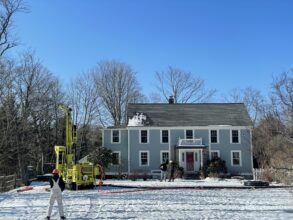This editorial was submitted as part of BuiltWorlds’ Verified Contributor Program.
The housing sector is a unique piece of the climate solution puzzle.
Individually, its impact is minimal. No single residential building meaningfully moves the climate needle in one direction or another. Collectively, the repercussions are enormous.
Taken together, U.S. housing is one of the most significant contributors to climate change, primarily due to heating and cooling. One report found that home heating and cooling systems release 441 million tons of carbon dioxide into the atmosphere each year. This number could be reduced by as much as 70% with a conversion from fossil fuel to geothermal heating and cooling.

Additionally, a United Nations analysis found that the housing sector, including heating, cooling, and development of residential areas, is responsible for 37% of total emissions, a staggering total that illustrates housing’s impact on climate change.
How Housing and Climate Collide
New construction has an opportunity to positively impact climate outcomes from day one with benefits that last for decades. The purchase of HVAC units is a must-have for every new home built, so opting to go with geothermal heat pumps is the most effective point to do so and future proofs the home against having to retrofit to a sustainable source of heating and cooling later in the building’s life cycle.
For example, when developments install natural gas lines, those fossil fuels will service the home for most of its lifespan, prompting some states, including New York, to ban their installation for new housing developments. In the same way, when new homes are built with renewable energy solutions, they promulgate positive outcomes.
In 2024, housing’s impact on climate is merging with another challenge: a profound housing shortage making it more difficult for millions of people to attain affordable housing.
One recent Axios analysis found that the U.S. housing market is short 3.2 million homes, noting “there aren’t enough homes to keep up with the increase in households.”
To be sure, both of these challenges defy simple solutions. However, when buyers, builders, developers, and policymakers address these challenges together, we can create large-scale climate-resilient housing.
Specifically, integrating geothermal heating and cooling from day one will minimize environmental impact, heighten sustainability, and help ensure long-term affordability.
What is Geothermal Heating and Cooling?
Geothermal heating and cooling leverage the consistent temperature just a few feet below the surface to provide a critical climate control solution that keeps homes warm in the winter and cool in the summer.
Geothermal heating and cooling solutions rely on two components: a heat pump inside the home that typically replaces a traditional furnace and a buried pipe system called ground looks that circulates heat transfer fluid.
It’s an ongoing process as the heat pump and circulating fluid continuously transfer heat, drawing warm air from the home in the summer and delivering warm air to the house in the winter.
Furthermore, geothermal’s minimal upfront impact on the electrical grid means it can be responsibly installed at scale without requiring costly infrastructure upgrades or minimizing its positive climate impact.
Geothermal heating and cooling does not introduce a new peak load, allowing the grid the crucial time it needs to transition to higher capacity, cleaner solutions. Geothermal’s integration ability is a game-changer as we imagine a future where clean, localized, and even microgrid energy sources become more feasible and commonly integrated into communities across the country.
Geothermal is Good For Builders and Buyers
Simply put, geothermal heating and cooling is the most efficient heating and cooling option, future-proofing buildings in an era where electrification and clean energy sources are paramount.
Geothermal reduces HERS rating scores, which helps to meet building performance standards such as EnergyStar, Net Zero, and Net Zero Ready.
Meanwhile, the cost of installing and maintaining geothermal has plunged. The EPA explains, “Geothermal heat pumps are the most energy-efficient, environmentally clean, and cost-effective systems for heating and cooling buildings.”
With regulatory and utility support making it accessible to more people and the Inflation Reduction Act adding significant financial incentives for installing geothermal heating and cooling solutions, this technology is now more affordable and accessible at every stage of the building process.
Long-term, geothermal future-proofs homes by relying on electrification rather than natural gas, ensuring that homeowners don’t have to retroactively adapt to shifting norms, policy standards, and climate change realities.
Make the Move Now
As the U.S. looks to address its prolific housing shortage, it has an opportunity to help solve the climate crisis simultaneously.
By installing renewable energy solutions, including geothermal heating and cooling, in new residential buildings, builders and buyers are investing in the present and future, adopting a cost-effective, energy-efficient heating and cooling solution that works.
In contrast, sticking with the status quo means that another generation of homes will be predicated on outdated technologies that don’t advance climate outcomes.
Every stakeholder has a unique opportunity to adopt a win-win solution. It’s an opportunity we don’t want to pass us by.
Wyatt Roberts is Head of Channel Development for Dandelion Energy. He is a builder and a building scientist, and is passionate about reducing the impact of our built world on the global environment. See Dandelion Energy’s BuiltWorlds profile.

Discussion
Be the first to leave a comment.
You must be a member of the BuiltWorlds community to join the discussion.